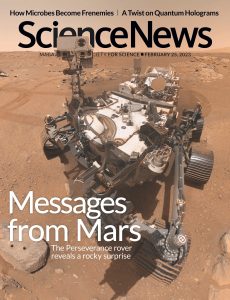
Science News – 25 February 2023
English | 36 pages | pdf | 7.93 MB
Welcome at Science News Magazine 25 February 2023 Issue
What field of science could be more solid than geology? Rocks are visible, tangible. You can bang on them with a hammer, drill them, compress them, zap them with X-rays, ultraviolet light and radar, analyze their chemistry, extract their secrets.
The study of human behavior, by contrast, is the story of science’s struggle to identify the ineffable. Researchers have taken wildly different approaches to trying to figure out how people think and behave, from Sigmund Freud’s notion of the Oedipus complex to making behavioral science more “scientific” through efforts such as the Diagnostic and Statistical Manual of Mental Disorders and fMRI brain scans. Human life is messy, and no hammer tap will reveal the brain’s workings.
This magazine issue of Science News articulates that duality in two features. Our cover story reports on the geology and chemistry of Mars, with NASA’s Perseverance rover scouting the Red Planet for rocks that could reveal signs of past life (Page 22). In “Broken timelines,” social sciences writer Sujata Gupta investigates efforts to understand how life crises can cause some people to lose their sense of self and vision of the future. Helping people restore that vision, some researchersbelieve, could be a balm for PTSD and suicidal thinking (Page 16).
As I read Gupta’s article, I could sense the scientists’ effort to quantify people’s experiences through definitions — self-continuity, autobiographical reasoning. These terms were new to me, and I found myself having to read closely to be sure I understood what the scientists meant. I took comfort in Gupta’s observation that philosophers have been wrestling with these questions for millennia. There are no easy answers.
When I turned to freelance writer Liz Kruesi’s account of the first two years of the Perseverance mission, I thought, “Ah, easy.” Find rocks, study rocks, confirm or reject hypotheses. NASA scientists directed the rover to the Jezero crater, the site of a dry lake bed that they presumed would be made of sedimentary rocks — the type of rock most likely to preserve evidence of ancient life. To their astonishment, the rover, affectionately known as Percy, instead found igneous rocks from past magmatic activity. The story was more complicated than most scientists thought.
Percy has since rolled on to a new location, the front of a dried-up delta, where it has found the sedimentary rocks the scientists were hoping for. The rover continues in its work as a robot geologist and astrobiologist, taking photos and collecting samples that are revealing the chemistry of the rocks. Bit by bit, that information will help scientists piece together the complex story of the planet’s history. Someday, they may even be able to answer the big question of whether life once thrived on Mars.
So maybe rocks and humans aren’t such different research subjects after all. Simple questions lead to complicated and contradictory data, with new discoveries challenging what we thought we knew to be true. As we learn, we rewrite the story of the past and get a clearer sense of what the future may hold. And so many questions remain to be answered. — Nancy Shute, Editor in Chief
Download from: